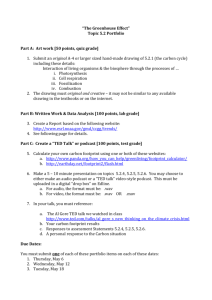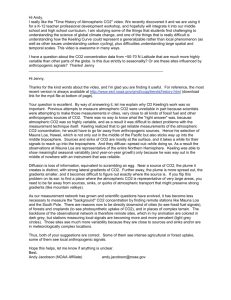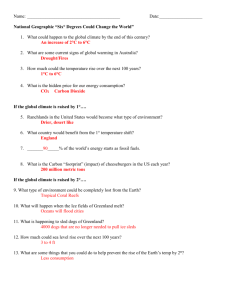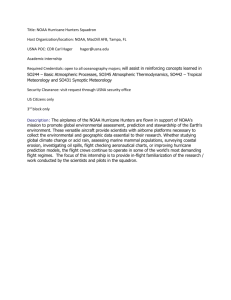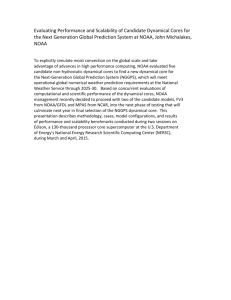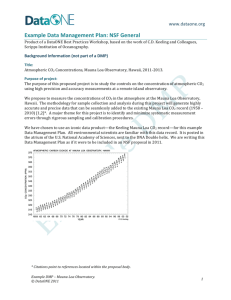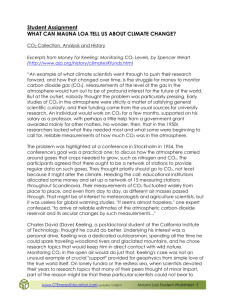Activity handout
advertisement
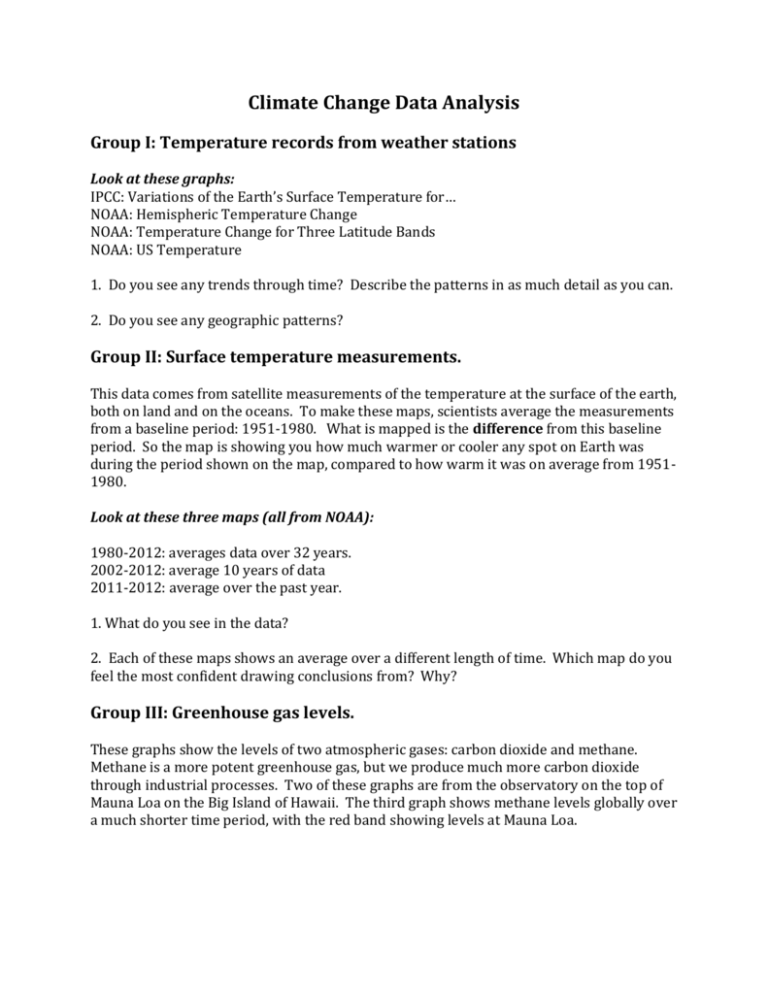
Climate Change Data Analysis Group I: Temperature records from weather stations Look at these graphs: IPCC: Variations of the Earth’s Surface Temperature for… NOAA: Hemispheric Temperature Change NOAA: Temperature Change for Three Latitude Bands NOAA: US Temperature 1. Do you see any trends through time? Describe the patterns in as much detail as you can. 2. Do you see any geographic patterns? Group II: Surface temperature measurements. This data comes from satellite measurements of the temperature at the surface of the earth, both on land and on the oceans. To make these maps, scientists average the measurements from a baseline period: 1951-1980. What is mapped is the difference from this baseline period. So the map is showing you how much warmer or cooler any spot on Earth was during the period shown on the map, compared to how warm it was on average from 19511980. Look at these three maps (all from NOAA): 1980-2012: averages data over 32 years. 2002-2012: average 10 years of data 2011-2012: average over the past year. 1. What do you see in the data? 2. Each of these maps shows an average over a different length of time. Which map do you feel the most confident drawing conclusions from? Why? Group III: Greenhouse gas levels. These graphs show the levels of two atmospheric gases: carbon dioxide and methane. Methane is a more potent greenhouse gas, but we produce much more carbon dioxide through industrial processes. Two of these graphs are from the observatory on the top of Mauna Loa on the Big Island of Hawaii. The third graph shows methane levels globally over a much shorter time period, with the red band showing levels at Mauna Loa. Look at this data: NOAA: Atmospheric CO2 at Mauna Loa Observatory NOAA: Recent monthly mean CO2 at Mauna Loa NOAA: Annual mean growth rate of CO2 at Mauna Loa NOAA: Global Methane 1. Do you see any patterns over time? 2. Do you see any geographic patterns? Group IV: Carbon producers Look at this data: Gapminder: CO2 production 1950, 1960, 1970, 1980, 1990, 2000, 2006 Gapminder: CO2 emissions per person v. GDP per capita On the maps, the size of the dot shows the total amount of carbon dioxide emitted per year. The graph shows the amount of CO2 emitted per person graphed against the per capita GDP. 1. What patterns do you see in CO2 production over time? 2. What parts of the world produce the most CO2 per person? 3. What is the relationship between the wealth of a country and CO2 emissions? Group V: Glaciers This data shows the change in length and in total mass of a group of 30 reference glaciers chosen from around the world to track changes in glacial ice. On the map, red means a loss, blue means again. The Spatio-Temporal maps show the gain and loss of mass from glaciers in different areas of the world. Look at this data: World Glacier Monitoring Service: Glacial length World Glacier Monitoring Service: Cumulative specific mass balance World Glacier Monitoring Service: Spatio-temporal overview on glacier mass changes World Glacier Monitoring Service: Mean annual mass balance of reference glaciers. 1. Do you see any patterns over time? 2. Do you see any geographic patterns? Group VI: Sea Level Look at this data: NASA/NOAA Topex/Jason data: this data is measured with satellites – Topex from 1994 to 2002, Jason after that. One set of data is the actual monthly data. In the other the seasonal affect has been removed from the data. NOAA Sea Level Online: The length and color of the arrow indicates the amount of the change. 1. Why is there a seasonal change in sea level? 2. On the graphs, do you see a pattern through time? 3. On the maps, do you see any geographic patterns? Overall, is sea level rising, falling or staying the same? Group VII: Shifting climate belts This data includes observations of climate belts that have already undergone change (1990-2006 charts), and projections of changes that will occur in the future. The graph explains what is meant by novel and disappearing climates. Look at this data: USDA: Plant Hardiness Zones 1990 & 2006 Williams paper: Mapped indices of climate zone shifts Williams paper: Projected distributions of novel and disappearing climates by 2100 AD 1. How have climate belts already shifted in North America? 2. Globally, where are the most endangered climates?
